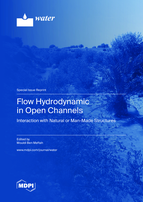Flow Hydrodynamic in Open Channels: Interaction with Natural or Man-Made Structures
A special issue of Water (ISSN 2073-4441). This special issue belongs to the section "Hydraulics and Hydrodynamics".
Deadline for manuscript submissions: closed (31 July 2022) | Viewed by 40804
Special Issue Editor
Interests: open channel flows; hydrodynamics; turbulent flows; vegetated channels; hydraulic structures; local scouring; hydraulic jumps; boundary layers; experimental and numerical modeling; coastal monitoring; maritime hydraulics
Special Issues, Collections and Topics in MDPI journals
Special Issue Information
Dear Colleagues,
This Special Issue aims to discuss hydrodynamic structures in open channel flows. It is a focal point and a platform for exchanging recent ideas among engineers, scientists, specialists, designers, and practitioners interested in this topic. Rivers and open-channel flows are the subject of considerable hydromorphological alterations due to the flow interaction with natural or man-made structures found through them, i.e., natural vegetation, grade control structures, piers and abutments, discharge/suction systems, seepage, and movable/fixed boundary.
Sustainable management and monitoring of rivers/channels requires deep knowledge and understanding of hydrodynamic flow structures. Thanks to advances in technological devices (sensors and software), measurements and numerical modeling of turbulent flows become easier and more accurate, giving rise to the enhancement of fluid–structure interaction studies.
I cordially invite you to participate in this Special Issue by presenting your original, recent results with experimental and/or numerical approaches in flow–vegetation interaction, sediment transport and local scouring around hydraulic structures, coherent turbulent flow structures, turbulent jets in cross flows, hydraulic jumps, the flow–boundary layer interaction problem, solitary waves and tidal bores, and other problems related to this topic.
Prof. Dr. Mouldi Ben Meftah
Guest Editor
Manuscript Submission Information
Manuscripts should be submitted online at www.mdpi.com by registering and logging in to this website. Once you are registered, click here to go to the submission form. Manuscripts can be submitted until the deadline. All submissions that pass pre-check are peer-reviewed. Accepted papers will be published continuously in the journal (as soon as accepted) and will be listed together on the special issue website. Research articles, review articles as well as short communications are invited. For planned papers, a title and short abstract (about 100 words) can be sent to the Editorial Office for announcement on this website.
Submitted manuscripts should not have been published previously, nor be under consideration for publication elsewhere (except conference proceedings papers). All manuscripts are thoroughly refereed through a single-blind peer-review process. A guide for authors and other relevant information for submission of manuscripts is available on the Instructions for Authors page. Water is an international peer-reviewed open access semimonthly journal published by MDPI.
Please visit the Instructions for Authors page before submitting a manuscript. The Article Processing Charge (APC) for publication in this open access journal is 2600 CHF (Swiss Francs). Submitted papers should be well formatted and use good English. Authors may use MDPI's English editing service prior to publication or during author revisions.
Keywords
- river and open channel flows
- hydrodynamic
- vegetation
- local scouring
- turbulent jets
- hydraulic jumps
- boundary layers
- solitary waves and tidal bores
- experiments
- numerical modeling






